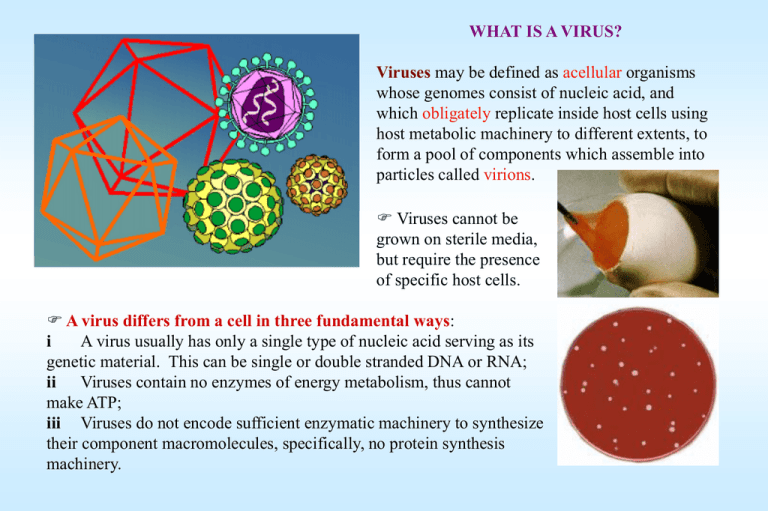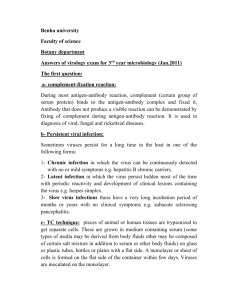- University of Evansville Faculty Web sites
advertisement

WHAT IS A VIRUS? Viruses may be defined as acellular organisms whose genomes consist of nucleic acid, and which obligately replicate inside host cells using host metabolic machinery to different extents, to form a pool of components which assemble into particles called virions. F Viruses cannot be grown on sterile media, but require the presence of specific host cells. F A virus differs from a cell in three fundamental ways: i A virus usually has only a single type of nucleic acid serving as its genetic material. This can be single or double stranded DNA or RNA; ii Viruses contain no enzymes of energy metabolism, thus cannot make ATP; iii Viruses do not encode sufficient enzymatic machinery to synthesize their component macromolecules, specifically, no protein synthesis machinery. Fundamentally then, a virus is: A package of genetic information protected by a protein shell for delivery into a host cell to be expressed and replicated Viruses are distinguished from other obligate parasites, some of which are even simpler than viruses: MYCOPLASMA: Small bacterium that grows only in complex medium or attached to eucaryotic cells. CHLAMYDIA: Obligate intracellular bacterial parasite which depends on eucaryotic cell for energy. PROTOZOA: Obligate intracellular parasite that replicate within eucaryotic cells. VIROID: Infectious agents of plants that exist as naked nucleic acid (circular single stranded (ss) ssRNA). HEPATITIS DELTA VIRUS (HDV): Viroid-like agent whose replication is dependent upon HBV. PRION (proteinacious infectious agent): Hypothesized identity of the unconventional slow viruses (such as the Kuru, Scrapie and “Mad cow” disease agents). No nucleic acid is known to be required for prion function. They are thought by many to consist solely of protein and perhaps lipids. Study of these agents has resulted in 2 nobel prize awards. Kuru Scrapie BSE vCJD BSE in Britian 80 70 CJD, nvCJD in Britian 60 50 40 30 20 10 0 1990 1991 1992 1993 1994 1995 1996 1997 1998 1999 2000 Recognition of viruses F How long viruses have been within our midst? 1500 BC: Leg deformities indicative of poliomyelitis, pock marks indicative of smallpox and. "Virus" is from the Greek meaning for "poison" and was initially described by Edward Jenner in 1798. During the 1800's, all infectious agents were considered to be viruses until Koch developed pure culture techniques which allowed the separation and growth of bacteria. In the late 1800's: Bacteria were purified and established as disease causing agents. It then became possible to distinguish them from the "filterable agents", those able to pass through special filters designed to prevent the passage of bacteria. The first viruses described were foot and mouth disease (a picornavirus), 1898, Yellow fever (a flavivirus), 1900, Rous sarcoma virus (an oncogenic retrovirus), 1906. Viral diseases have played a major role in human history over whatever time scale we choose to explore: Over the past 1000 years: Smallpox and measles were brought to North and South America by early European explorers/conquerers. These diseases, for which the native American populations had no acquired partial immunity, killed large fractions of the populations, and were a major factor in the decimation of these societies. Over the past 100 years: A newly emerged strain of influenza killed 20 million people in 1918-1919 in the immediate aftermath of World War I. A decade later, polio became one of the most feared infections of children and young adults (including Franklin D. Roosevelt, the U.S. President throughout the Depression and World War II). As the century entered its final 20 years, a new ~100% lethal virus, HIV, spread rapidly around the world via body fluid transmission. Over the past 10 years: As the global HIV epidemic continues, sporadic cases and outbreaks in humans of some non-human host viruses such as Ebola and Hanta raise the concern about future epidemics by other viruses in the new century. FourCorners Virus (Hanta) THE DISCIPLINE OF VIROLOGY The study of virology inherently involves a merging together of what has traditionally been thought of as two separate "kinds" of science: basic and applied science. We want to figure out how viruses are transmitted, how they replicate, and how the host organism responds. We also want to figure out how to prevent transmission, how to interfere with virus replicaton, and how to confer immunity on the host. The "applied" follows from, and is dependent upon, the "basic" in a quite direct way. Virology as it is studied today, is therefore an outgrowth of both: Infectious diseases - because of the recognition of viral pathogens. Molecular Biology- because of the usefulness of viruses as probes of cell and molecular biology and metabolism, and as vectors with strong potential for gene therapy. Mouse primary spleen cells transduced with a GFP (green fluorescent protein)-retrovirus vector WHERE WE STAND IN 2001: PREVENTING • CONTROLING • CURING VIRAL DISEASES Smallpox: effective vaccine; this is the only viral disease that has been wiped out worldwide Measles: effective vaccine since 1963; this disease could be eliminated with a world-wide effort Influenza: effective strain-specific vaccine, but new variant strains emerge periodically Polio: effective vaccine; will soon be the second viral disease wiped out HIV: no vaccine; effective drugs, but they are costly and toxic, plus resistant strains appear. World-wide spread continues via intimate contact. 50 million infected thus far Ebola: no vaccine; important host species unknown (found recently in chimps and rodents); outbreaks controllable because people die quickly and human-human transmission is via blood Hanta: no vaccine; rodent host; easy transmission to humans, but outbreaks controllable We also share the world, and our bodies, with viruses that cause hepatitis, respiratory disease, mononucleosis, diarrhea, genital warts, genital herpes, and some forms of cancer How are viruses classified ? Hierarchical virus classification: (order) family - subfamily - genus - species - strain/type All families have the suffix viridae, e.g.: * * * * Poxviridae Herpesviridae Parvoviridae Retroviridae Genera have the suffix virus. Within the Picornaviridae there are 5 genera: * * * * * enterovirus (alimentary tract), species e.g. poliovirus 1, 2, 3 cardiovirus (neurotropic), species e.g. mengovirus rhinovirus (nasopharyngeal region), species e.g. Rhinovirus 1a apthovirus (cloven footed animals ), species e.g. FMDV-C hepatovirus (liver), species e.g. Hepatitis A virus Virus naming and classification Usually based on data available at the time of discovery: i Disease they are associated with, e.g.: Poxvirus, Hepatitis virus, HIV, measles virus ii Cytopathology they cause, e.g.: Respiratory Syncytial virus, Cytomegalovirus iii Site of isolation, e.g.: Adenovirus, Enterovirus, Rhinovirus iv Places discovered or people that discovered them, e.g.: Epstein-Barr virus, Rift Valley Fever v Biochemical features, e.g.: Retrovirus, Picornavirus, Hepadnavirus RSV These naming conventions can lead to confusion later, e.g., viral hepatitis is caused by at least 6 different viruses “Infectious” Viral hepatitis “Serum” A E F, G, ? Other * NANB B Enterically transmitted C Parenterally transmitted D * 10-20% of cases of presumed viral hepatitis are still not accounted for Thus, Different viruses can cause (nearly) the same symptoms. e.g., the hepatitis viruses However, different members of the same group can cause different symptoms. e.g., the herpes viruses Herpesviruses HSV Herpes Simplex Virus VZV CMV EBV Varicella Zoster Virus Cytomegalovirus Epstein-Barr Virus and HHV-6, HHV-7, HHV-8….. (Human HerpesVirus-#) Cold sores (type 1), Genital lesions (type 2) Chicken pox Mononucleosis Mononucleosis, Burkitt’s lymphoma, Nasopharyngeal carcinoma Virus Classification is now based principally on analysis of the particle: Morphology: by electron microscopy Serology: antigenic cross-reactivity Genetic material: form of nucleic acid ssDNA (+ or - strand) dsDNA ssRNA (+ or - strand) dsRNA segmented RNA genetic organization sequence homology DNA sequence Hybridization Rotavirus Animal virus classification: DNA Viruses Family Pox Genome <---------------------------------------dsDNA--------------------------------------> Capsid symmetry Complex Envelope <-----------------Yes------------------> e.g. Vaccinia virus Molluscum Contagiosum Herpes Adeno Papova Parvo Hepadna ssDNA Partial dsDNA <---------------------------------------------Icosahedral--------------------------------------------------> Herpes simplex virus 2 <-----------------------------No------------------------------> Human adenovirus Papilloma AdenoAssociated Yes Hepatitis B Plus Sense RNA Viruses Plus-sense RNA viruses Family Genome Corona Toga/Flavi Picorna Calici <-------------------------------------------ss (+) RNA---------------------------------------------> Capsid symme try Helical Envelope e.g. <----------------------Yes--------------------> Human corona Rubella virus virus Hepatitis C vi rus Retro Diploid ( +) RNA <--------------------------------------Icosahedral-------------------------------------------------> <---------------------No----------------------> Polio Norwalk agent Hepatitis A vi rus Hepatitis E virus Yes HIV-1 Minus Sense RNA Viruses Minus-sense RNA viruses Family Genome Paramyxo Rhabd o Filo <-----------------ss(-) RNA------------------------> Capsid symmetry Envelope Orthomyxo Arena Bunya ss(-) RNA ss(+) or (+/-) ss(+) or (+/-) segments segments segments <---------------------------------------------------Helical-------------------------------------------------------> Reo ds RNA segments Icosahedral <----------------------------------------------------Yes-----------------------------------------------------------> No Measles Mu mps Parainfluenza Rotavirus e.g. Rabies virus Ebo la virus Influenza virus Lassa virus Hanta virus







